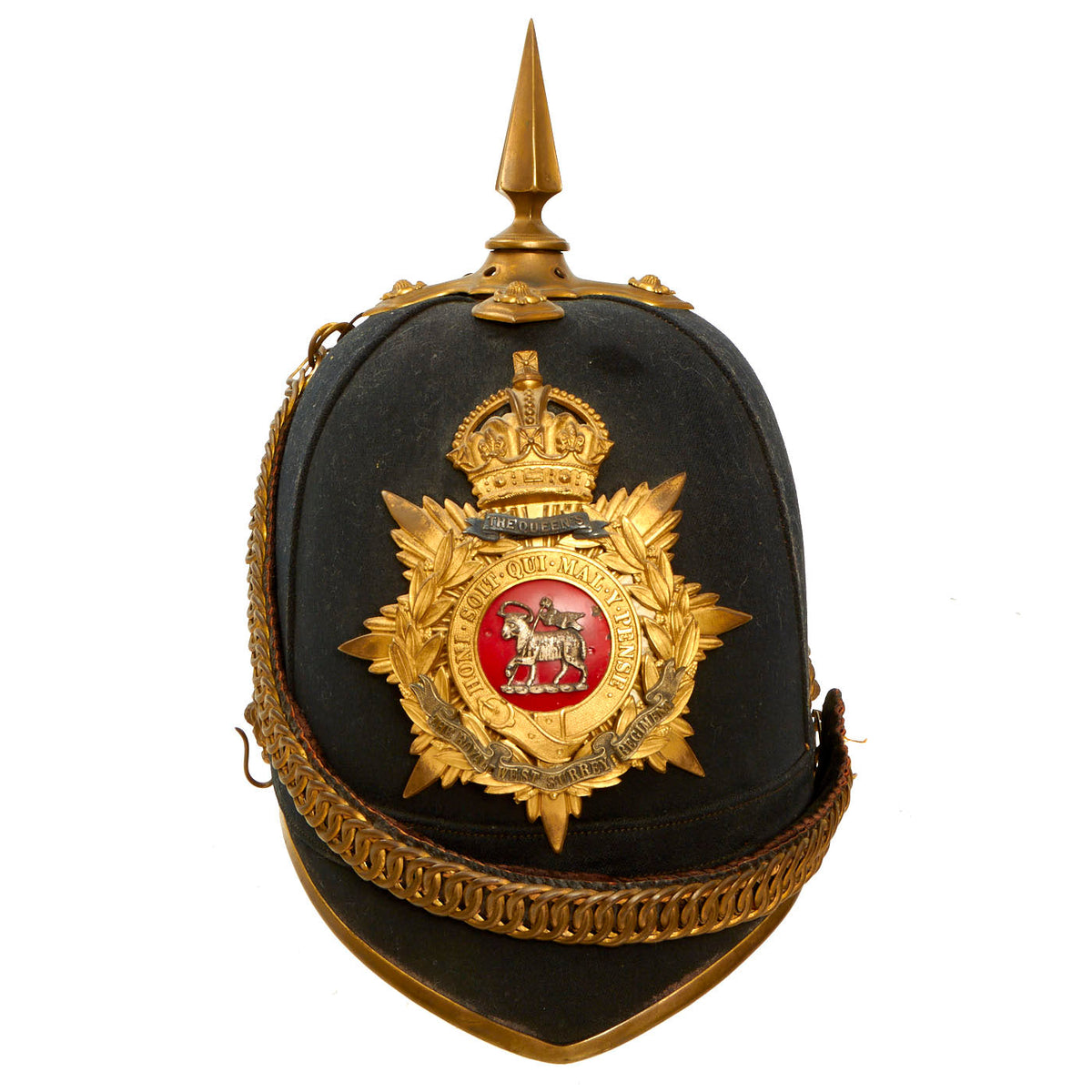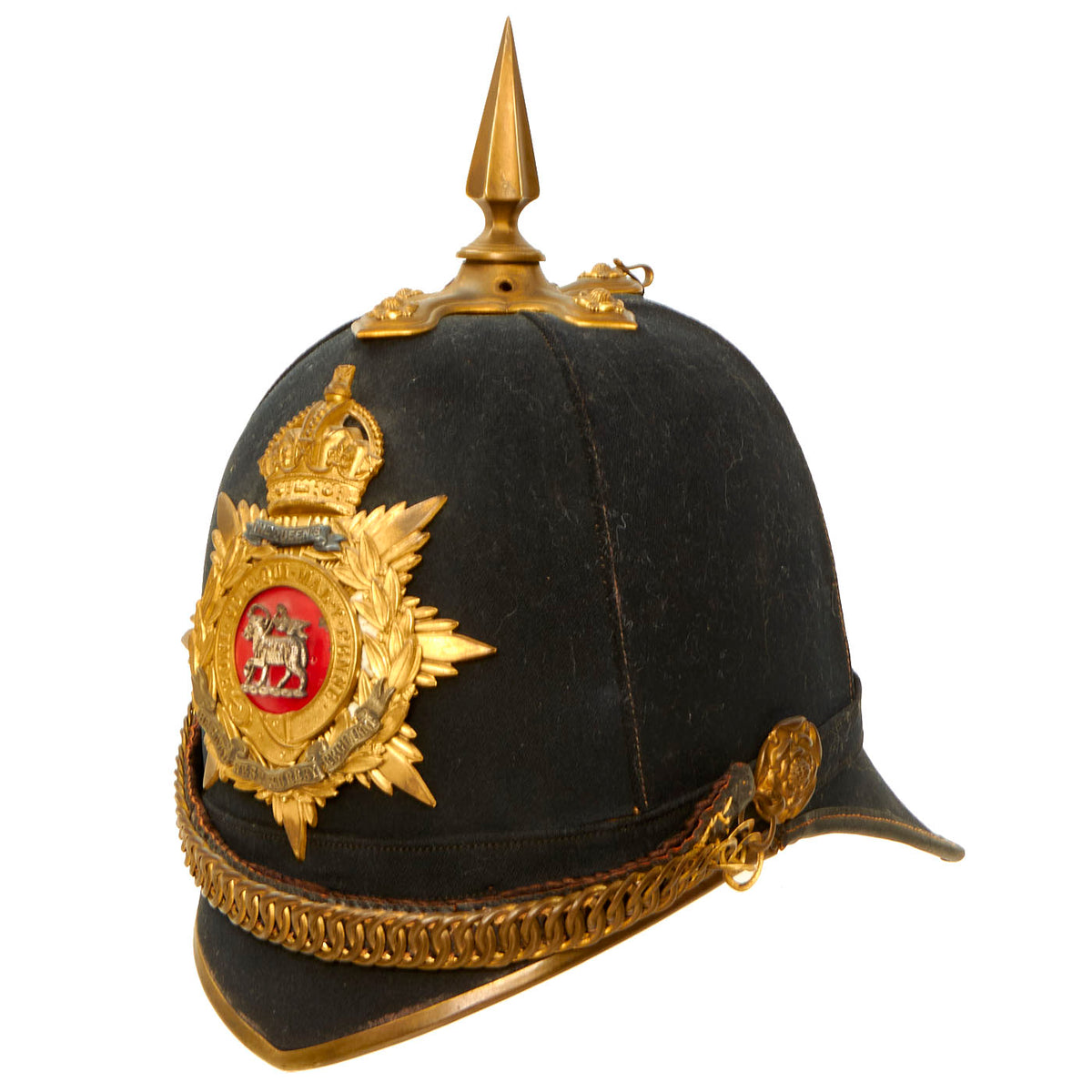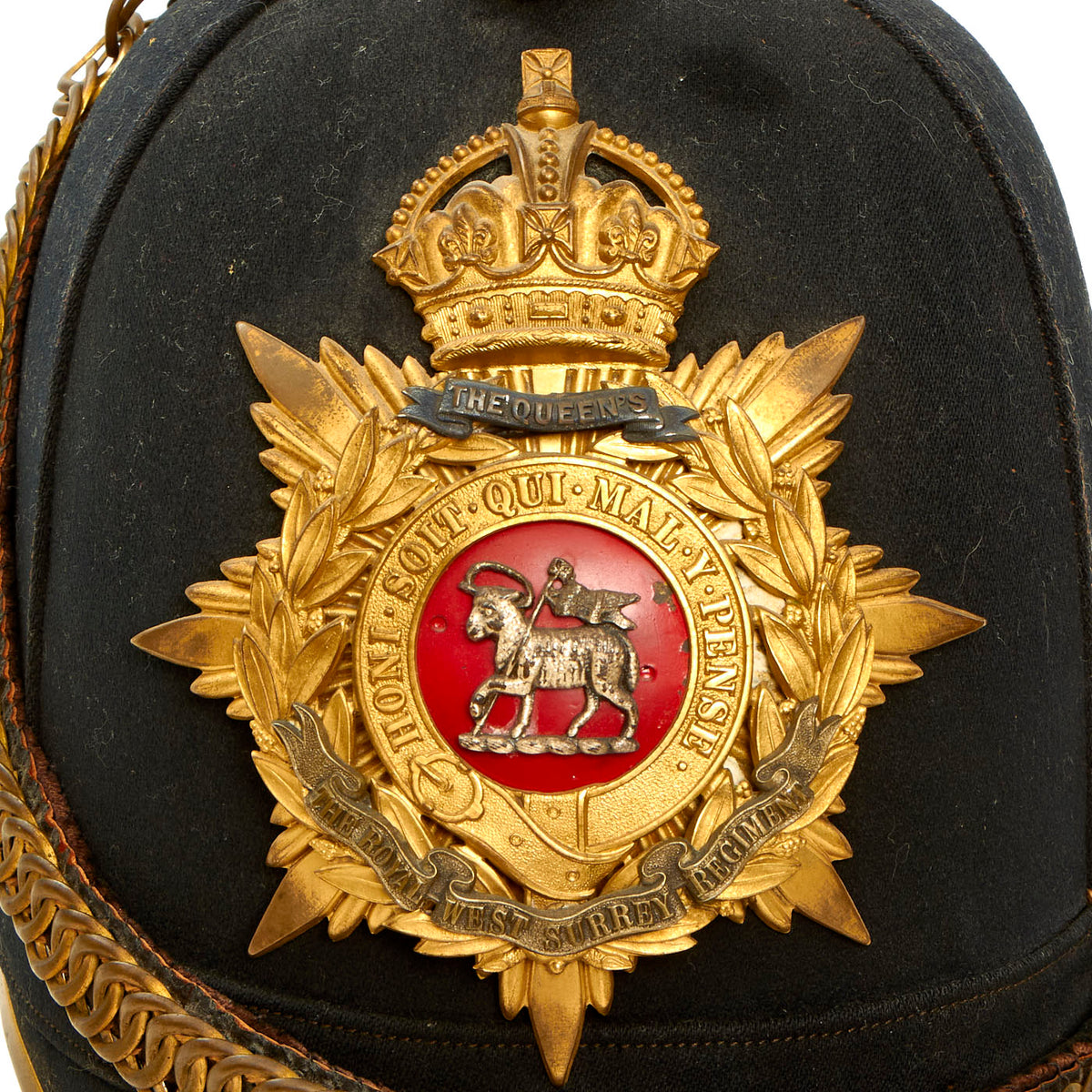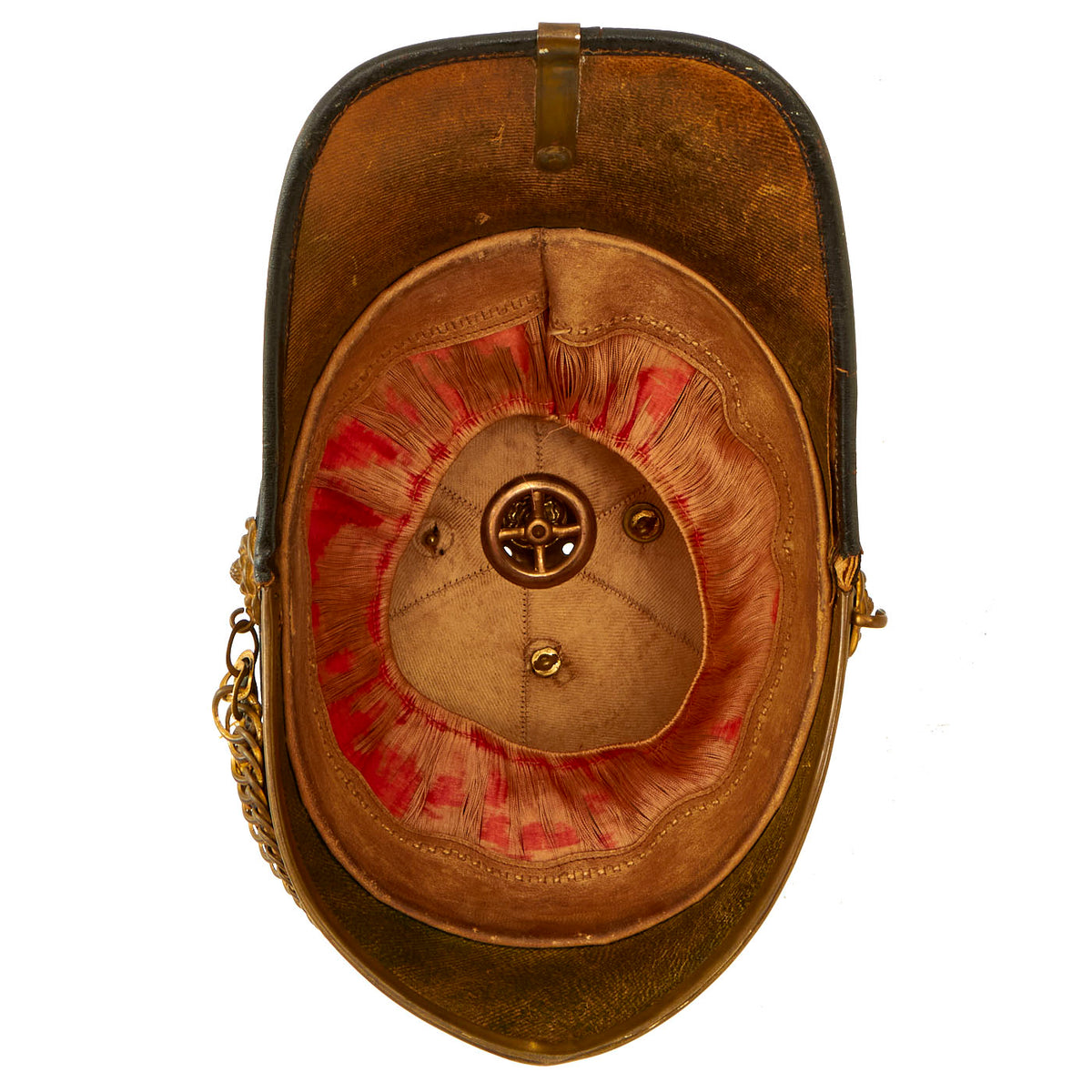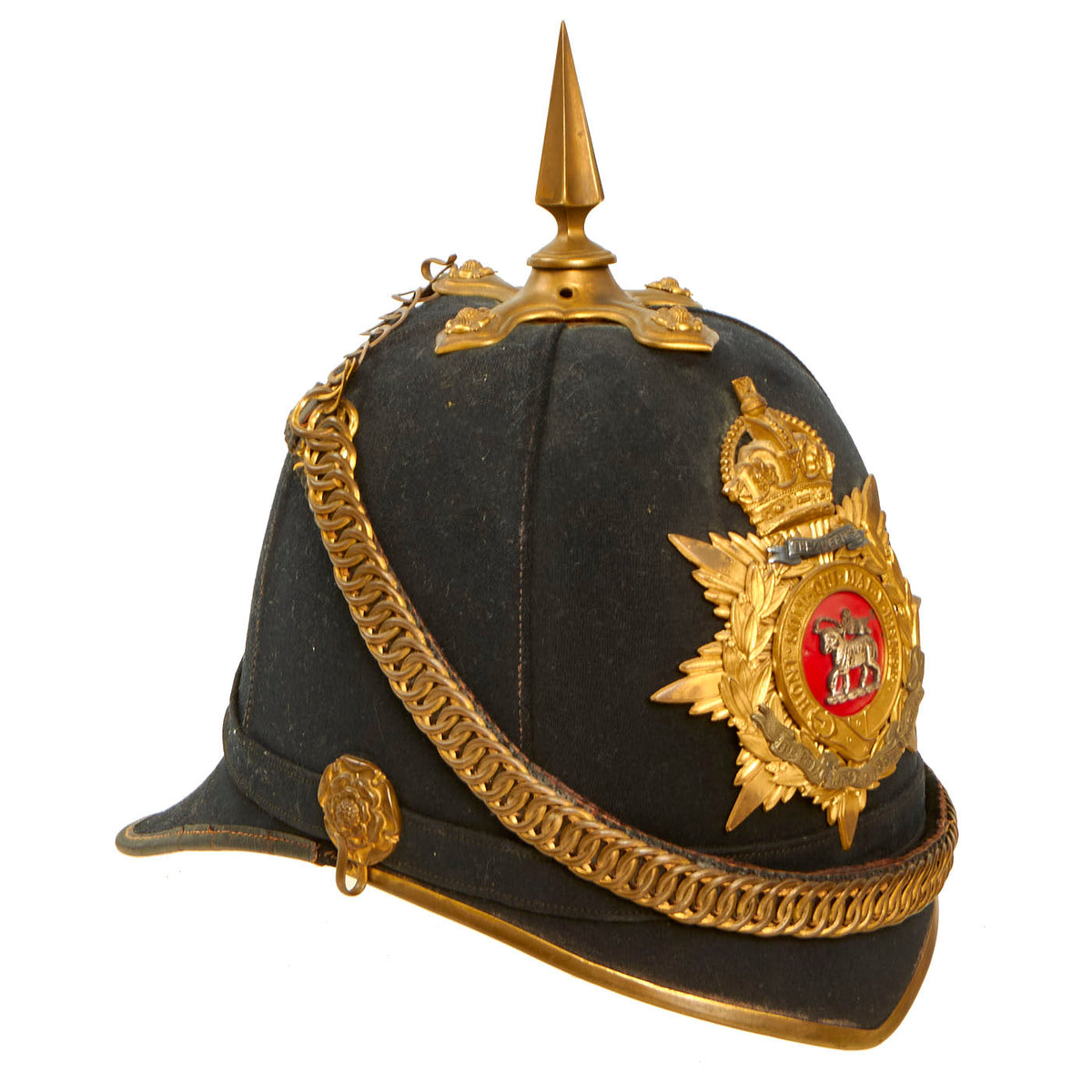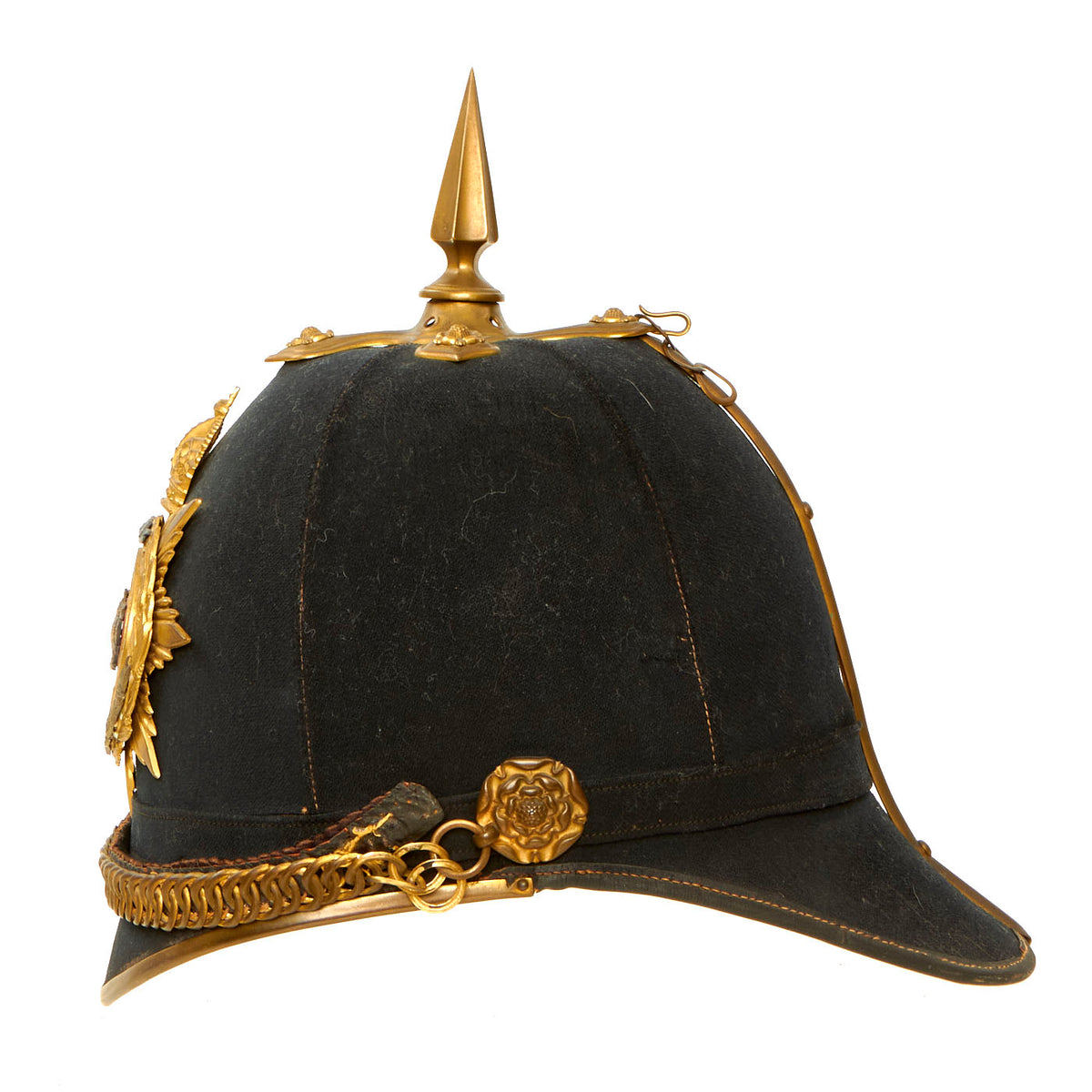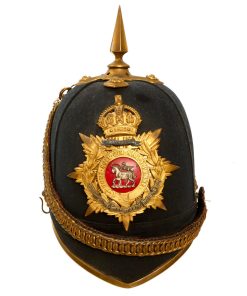Original British Victorian Royal West Surrey Regiment Officer Blue Cloth Dress Spike Helmet – Complete Original Items
$ 695,00 $ 208,50
Original Item: Only One Available. This is a well used but solid condition Victorian era British Army Officer Blue Cloth Spiked helmet which is complete with its spiked finial and scaled chinstrap. The chin strap lugs and spike base ends are all properly adorned with embossed roses. This helmet has gilt brass mounts used on all regular Army helmets.
The front of the helmet has the correct regiment plate for THE QUEENS / THE ROYAL WEST SURREY REGIMENT. Body consists of cork covered with blue wool, trimmed with brass. Liner is calfskin leather and has a worn silk lining. Interior of the front and rear visor is trimmed with fine green dyed leather, with the interior body lined with canvas.
The helmet is in fantastic condition for its age. Showing signs of honest use, and wear from storage and handling over the last 120+ years. Overall, this is an excellent example that is perfect for the collector of 19th Century British Militaria. Size is approximately US 7 (56cm).
Comes ready for display!
The Queen’s Royal Regiment (West Surrey) was a line infantry regiment of the English and later the British Army from 1661 to 1959. It was the senior English line infantry regiment of the British Army, behind only the Royal Scots in the British Army line infantry order of precedence.
In 1959, the regiment was amalgamated with the East Surrey Regiment, to form a single county regiment called the Queen’s Royal Surrey Regiment which was, on 31 December 1966, amalgamated with the Queen’s Own Buffs, The Royal Kent Regiment, the Royal Sussex Regiment and the Middlesex Regiment (Duke of Cambridge’s Own) to form the Queen’s Regiment. Following a further amalgamation in 1992 with the Royal Hampshire Regiment, the lineage of the regiment is continued today by the Princess of Wales’s Royal Regiment (Queen’s and Royal Hampshires).
The Victorian era
The regiment was on garrison duty in Baluchistan when the First Afghan War broke out in 1839. It formed part of the force that attacked the previously-impregnable city of Ghazni, taking the city by storm because the army lacked siege equipment, and opening the way to Kabul. It returned to India in November 1839, storming the city of Khelat en route, and avoiding destruction along with the rest of Elphinstone’s army.
The regiment was shipped to the Cape Colony during the Eighth Xhosa War in 1851. On 25 February 1852 a detachment of 51 men under the command of Ensign Boyland were aboard HMS Birkenhead traveling from Simon’s Town to Port Elizabeth when the ship struck rocks. The troops were assembled on deck and remained at attention to afford the embarked women and children time to take their place in the lifeboats. Shortly after this the ship broke up and the vast majority of the troops on board were either drowned or fell victim to sharks. The bravery of the troops, made up of cadres from ten different regiments, led to the naming of the Birkenhead Drill. It once again became the 1st Battalion when the 2nd Battalion was reformed in 1857, and went to China in 1860 at the time of the Second Opium War, fighting at the Third Battle of Taku Forts and the capture of Beijing. It was stationed in the Imperial fortress colony of Bermuda from 1864 to 1866. Although too far North for yellow fever to establish itself in perpetuity, the disease was introduced to Bermuda several times during the 19th Century by mail boats from the West Indies, causing endemics that resulted in many deaths, most particularly among members of the armed forces. Under the command of Lieutenant-Colonel F. L. O. Attye, the battalion arrived at the Royal Naval Dockyard, Bermuda (aboard HMS Orontes from Gibraltar, via Madeira) on the 15 July 1864, in the midst of one of these epidemics and its losses in Bermuda included Assistant Surgeon James Murray Chalk at St. George’s Garrison on 8 February 1865 and Douglas James Mounteny Rose, the five year old son of Lieutenant-Colonel Rose, who died the following day. The battalion lost fifty-two officers and men in the epidemic.[28] The battalion departed Bermuda for Cork, Ireland, under the command of Lieutenant-Colonel Werge, aboard HMS Orontes on the 3 November 1866.
The regiment was not fundamentally affected by the Cardwell Reforms of the 1870s, which gave it a depot at Stoughton Barracks in Guildford from 1873, or by the Childers reforms of 1881 – as it already possessed two battalions, there was no need for it to amalgamate with another regiment. Under the reforms it became The Queen’s (Royal West Surrey) Regiment on 1 July 1881. In 1897–98, a battalion took part in the Tirah Expedition on the North-West Frontier.
The 1st battalion was stationed at Malta from 1891, then in India where it was posted at Rawalpindi until late 1902 when it moved to Peshawar near the historic Khyber Pass on the border to Afghanistan. The 2nd Battalion fought in the Third Anglo-Burmese War from 1886 to 1888 and in South Africa from 1899 to 1904 including during the Second Boer War (1899–1902). From 1912 through 1914 it was stationed in the Imperial fortress colony of Bermuda, as the regular infantry battalion of the Bermuda Garrison. While in Bermuda, the Edison Studios filmed The Relief of Lucknow and For Valour there, and was provided extensive support from the garrison, with parts of Prospect Camp providing sets, and personnel from the 2nd Battalion appearing as extras.
A 3rd (Militia) Battalion was formed from the former 2nd Royal Surrey Militia, with headquarters at Guildford. The Battalion was embodied in December 1899 to provide troops for the Second Boer War, 550 men embarked for South Africa in February 1900; and returned to the United Kingdom in May 1902, when it received a public welcome and reception at Guildford.
Under the Childers Reforms, two battalions of the Volunteer Force were attached to the regiment in 1883. These had originally been raised in 1859–60 in response to an invasion scare. The 1st Volunteer Battalion (VB) was formed from the 2nd Surrey Rifle Volunteer Corps (RVC), at the Old Barracks, Mitcham Road, Croydon, while the 2nd VB was formed from the 4th Surrey RVC at Reigate. Both Volunteer Battalions contributed to service companies of volunteers who served alongside the regulars during the Second Boer War, and received the battle honor for the campaign.
Under the Haldane Reforms of 1908 the Militia became the Special Reserve and the Volunteers became part of the Territorial Force (TF). The regiment now had the 3rd Battalion (Special Reserve), with the 4th Battalion (TF) at the Old Barracks in Croydon and the 5th Battalion (TF) at Sandfield Terrace in Guildford (since demolished).
Fast Shipping with Professional Packaging
Thanks to our longstanding association with UPS FedEx DHL, and other major international carriers, we are able to provide a range of shipping options. Our warehouse staff is expertly trained and will wrap your products according to our exact and precise specifications. Prior to shipping, your goods will be thoroughly examined and securely secured. We ship to thousands clients each day across multiple countries. This shows how we're dedicated to be the largest retailer on the internet. Warehouses and distribution centres can be located throughout Europe as well as the USA.
Note: Orders with more than one item will be assigned a processing date depending on the item.
Before shipping before shipping, we'll conduct a thorough inspection of the items you have ordered. Today, the majority of orders will be delivered within 48 hours. The delivery time will be between 3-7 days.
Returns
The stock is dynamic and we cannot completely manage it because multiple stakeholders are involved, including our factory and warehouse. So the actual stock may alter at any time. It's possible that you may not receive your order once the order has been made.
Our policy is valid for a period of 30 days. If you don't receive the product within 30 days, we are not able to issue a refund or an exchange.
You can only return an item if it is unused and in the same state as the day you received it. You must have the item in its original packaging.
Related products
Uncategorized
Uncategorized
Uncategorized
Uncategorized
Uncategorized
Uncategorized
Uncategorized
Uncategorized
Uncategorized
Uncategorized
Armoured Fighting Vehicles of the World: AFVs of World War One (Hardcover Book) New Made Items
Uncategorized
Australian WWII Owen MK1 Machine Carbine SMG Custom Fabricated Replica with Sling Original Items
Uncategorized
Uncategorized
Uncategorized
Uncategorized
Uncategorized
